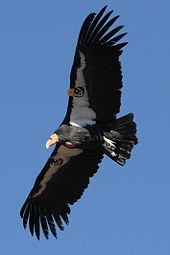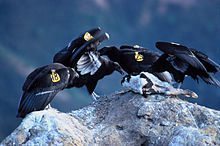The condor recovery debate, 30 years later
By Burr Heneman
Rich Stallcup was the giant of birding in Northern California and beyond. There is so much to miss about him now that he’s no longer with us in person. To be with him in the field and glimpse the “feathered nation” — or snakes or salamanders or butterflies — was to fall in love with them for life. Rich could also write beautifully, and from the heart. He wrote most of all about birding, but there were occasional thoughtful and thought-provoking pieces on hard issues that he couldn’t remain silent about.
Rich wrote “Farewell Skymaster” (below) in 1981 for a special 20-page Point Reyes Bird Observatory Newsletter devoted entirely to the California Condor. Today, with more than 400 condors in the skies over California, Arizona, and northern Baja, it’s hard to imagine the controversy and deep divisions within the ornithological and birding communities caused by the condor recovery program 30 years ago.
The condor population was falling steadily and had dwindled to 22 birds in the wild. The question that engendered fierce debate was whether, as a last resort, to bring all of those birds into captivity for a captive breeding program in spite of a failed attempt in the 1950s. The National Audubon Society, co-founder with the U.S. Fish and Wildlife Service of the Condor Research Center, supported the plan. Golden Gate Bird Alliance, the largest NAS chapter, vigorously opposed it.

Some of the field biologists most familiar with condors believed the experiment would be doomed to failure — the birds were just too fragile. Moreover, if they could be induced to breed in captivity, their every-other-year breeding cycle would not produce enough offspring to make a difference. Dave Desante summarized that view in a closely reasoned article in the Newsletter.
Meanwhile, experts in breeding birds in captivity at the San Diego Zoo and Los Angeles Zoo believed they could succeed and wanted the chance to prove it. In any case, it was the only chance to save the species. S. Dillon Ripley, then head of the Smithsonian and a respected ornithologist, represented that perspective in an interview I did with him for the Newsletter in which he urged the decision-makers to “take the ultimate risk.”
PRBO board member Frank Pitelka of UC Berkeley, another leading ornithologist and conservation biologist, argued in the Newsletter that the millions of dollars needed for a risky condor recovery program would be better invested in less expensive efforts to save many other endangered species.
And there was Rich’s article, reproduced below, the briefest and most eloquent of the pieces in the condor Newsletter.
Farewell, Skymaster
For me, there is no question as to what must and must not be done.
Because of habitat destruction — a direct result of the sprawl of Homo sapiens — the ultra-sensitive condors have been pressed from all directions into their last stronghold. The species is ecologically extinct, and we owe “freedom of the sky” to the remaining few. A grounded condor couldn’t be much happier than a grounded whale.
The interagency recovery teams (which desire captive propagation) have been composed, with few exceptions, of excellent and caring people, most of whom probably truly like the big birds. But must we still try to conceal the guilt of condor spoilage? Must we burden and demean the doomed skymasters with electronic trinkets, then imprison them in boxes and demand that they reproduce? Or can we just say, “Yes, el condor, we blew it long ago, we’re sorry. Fly, stay as long as you can, and then die with the dignity that has always been yours.”
I feel the program has failed to recover what has been truly lost. Science (technology) is how we got to these problems. Science is what has insulted the condors’ pride and pushed them to the brink. I here make a plea to leave science by the wayside in this case. Make the few wild condors as safe and comfortable as possible by diligently protecting their remaining range. Enjoy them, love them, grieve for them . . . but do not touch them.
Let the agencies and other supporters of captive condor propagation take a deep breath and count to ten. We have here an exception to the rule that humans must organize all earthly transactions. Our proper handling of the condor crisis must be redefined from one of management to one of humble reverence. Let them fly.

Given the astonishing success of the captive breeding program over the past 30+ years, did Rich make the wrong call? Today, as in the 1980s, this is not a question that science can answer. Each of us must decide for ourselves.
I don’t know what Rich would say now, but consider this: We have hundreds of California Condors instead of 22. Each one flies with a leg band, a highly visible identification tag on one wing, and both VHF radio and satellite transmitters. Since bullet fragments from the remains of deer skinned and gutted by hunters and left in the field is the leading cause of condor mortality, recovery program staff regularly set out clean animal carcasses at feeding sites for each of the wild populations to reduce the risk of lead poisoning. And one goal of the recovery program is to capture each bird twice a year for blood tests and other health monitoring.
We might ask, Are we saving the condor, or are we operating a very large, free-range condor zoo? And do they have the dignity that Rich argued for?
The question that Rich and the other authors debated in the Newsletter is not just of historic interest. At a time when climate change is endangering more species, we increasingly need to decide which to save, which to abandon, and what criteria to use, both scientific and philosophical, to make those god-like decisions.
I’ll miss Rich’s voice in those debates.
——————————–
Burr Heneman, a former executive director of PRBO – Conservation Science, currently works with two colleagues on a Galapagos Penguin conservation biology project and is a director of the Charles Darwin Research Station. He previously wrote for Golden Gate Birder about the Swainson’s Thrush.
